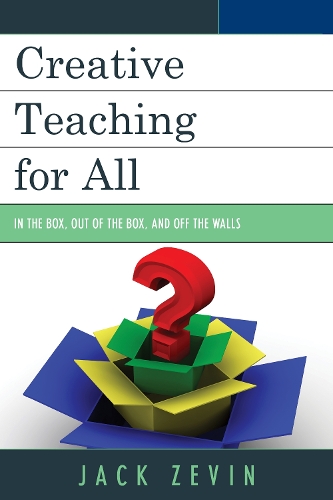
Creative Teaching for All: In the Box, Out of the Box, and Off the Walls
(Paperback)
Publishing Details
Creative Teaching for All: In the Box, Out of the Box, and Off the Walls
By (Author) Jack Zevin
Bloomsbury Publishing PLC
Rowman & Littlefield Education
13th March 2013
United States
Classifications
General
Non Fiction
371.102
Physical Properties
Paperback
222
Width 151mm, Height 227mm, Spine 16mm
331g
Description
Read Creative Teaching for All as an antidote to rapidly growing pressures for quick and easy teacher results, and constant evaluations. Employ creative ideas to resist teaching to the (usually factual) test, and to the many choking rules, standards, cores, and state regulations that strangle motivation and destroy experimentation.
Reclaim teacher control of curriculum design and instructional methods across all fields by boldly going outside, even off the walls, where teachers have lived happier lives before the invention of rubrics and rules.
Become the truly creative teacher to which you have aspired!
Highlights of the book:
Explores and expands opportunities for engaging student conversation and ideasAdds variety and depth to your teaching methodsHone questioning and critical thinking skillsMove from lower to higher levelsReinvent instruction at home, work, or in classrooms as places of imagination and enjoyment.
Reviews
Zevin posits in part 1 that traditional teaching is failing primarily because teachers are too comfortable staying inside the box. The constrictive environment of schools has left teachers few alternatives but to provide students with correct answers to memorize, pacify students through direct instruction, and dispense information through mind-numbing PowerPoints. This has become the norm and falls short of the educational mental health that would occur through creative teaching. Citing Jerome Bruner, Benjamin Bloom, and John Dewey, Zevin proposes collaboration and an atmosphere of playfulness. Disappointingly, the arsenal of creative teaching tactics in part 1 is limited to strategies, such as mock trials or debates. Refreshingly, part 2 is an analysis of six engines of creativity with many outside-the-box scenarios offered. The first engine, creative attention, is awakened through careful observation. In the second, those individual observations are aroused by inductive examination identifying concepts, categories, and metaphors. The third engine, curiosity, calls for hypotheses. Through the fourth engine, students are presented with contradictions, ambiguities, or converging views. Next, those perspectives are explored. Finally, temporary evaluations are drawn. Overall, Zevin's book is a tribute to creative teaching. Summing Up: Recommended. Graduate and professional collections. * Choice Reviews *
Zevin's book is critical reading for teachers as well as other individuals concerned with the kind of education that our students need and crave. In this day of standardization of curriculum and tests, Zevin provides a path for teachers and students who wish to become critical thinkers, problems
solvers, lifelong learners and, most importantly, creative in the way they approach the tasks of their daily lives. Teaching, learning and living are all enhanced when a person takes the ideas in Zevin's book and incorporates them into their repertoire of skills.
Explore and expand opportunities for engaging student conversation and ideas; add variety and depth to your teaching methods; hone questioning and critical thinking skills, moving from lower to higher levels; and reinvent instruction at home, work, or in classrooms as places of imagination and enjoyment.
In short, jump out of the narrow little box of pedagogical techniques into a big, wide, wonderful world of possibilities and excitement!
Read Creative Teaching for All as an antidote to rapidly growing pressures for quick and easy teacher results, and constant evaluation. Employ creative ideas to resist teaching to the (usually factual) test, and to the many choking rules, standards, common cores, and state regulations that strangle motivation and destroy experimentation.
Reclaim teacher control of curriculum design and instructional methods across all fields by boldly going outside, even off the walls, where teachers have lived happier lives before the invention of rubrics and rules.
Author Bio
Jack Zevin is professor of education at Queens College/CUNY who began pedagogical life as a teacher on the South side of Chicago. Teaching is a passion as much as a profession for Jack, and he has contributed many articles, books, and curricula to enhance and enrich instruction for those willing to try creative approaches inside and outside classrooms.
